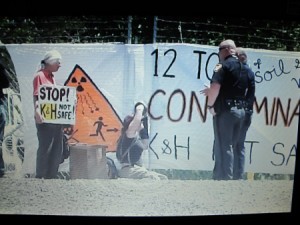Fracking waste stirs controversy in Athens, Ohio
From an Article by Laura Arenschield, The Columbus Dispatch, April 5, 2015
Torch, OH — The tractor-trailers arrive at a steady pace, turning off Rt. 50 and climbing a hill to a collection of tall, green metal tanks. The trucks haul long, white tanks that are bare except for a number that identifies their company and one word that has riled a vocal population in Athens County: brine.
Brine is another name for the fracking wastewater (“residual waste”) that bubbles up in oil and gas wells in Ohio, Pennsylvania and West Virginia.
The wastewater is laced with toxic chemicals used during hydraulic fracturing, a process in which millions of gallons of water, sand and chemicals are pumped underground to crack shale and free oil and gas trapped within it. Much of the fracking fluids come back up and most often are sent to disposal wells, where they are pumped back underground.
Athens County, known for its progressive politics and college-town vibe, took the third-highest amount of fracking wastewater in the state last year. A new injection well, approved last month by the Ohio Department of Natural Resources, could boost Athens to the top in wastewater injections.
That’s a dubious distinction, according to Athens County activists and some elected officials. “There’s probably not a county in the state that has as much activism objecting to the injection wells as Athens,” said Roxanne Groff, a trustee in Bern Township in eastern Athens County.
Almost 25 million barrels of wastewater were pumped into about 200 injection wells in Ohio last year, according to ODNR records. More than one-tenth of that — about 2.9 million barrels — was injected into seven Athens County wells last year. Nearly 2.5 million barrels went into two of those wells, both owned by K&H Partners, a company based in West Virginia.
On March 18, the ODNR issued a permit to K&H for a third injection well in eastern Athens County. As many as 12,000 barrels of fracking wastewater could be injected into that well every day, though K&H in its application estimated an average of 5,000 barrels would be injected every day.
That would increase Athens County’s annual total by as many as 4.4 million barrels, putting Athens well above Coshocton County, where about 3.5 million barrels of fracking wastewater were injected last year, leading the state.
Andrew Adgate, an ODNR geologist involved in permitting injection wells, said that Athens County’s location makes it a prime spot for fracking wastewater. “It’s close to where the waste from the oil and gas operations is produced,” Adgate said.
Bob Worstall, a geologist and deputy chief of Natural Resources’ oil and gas division, said the state requires companies to build casings at the top of each injection well to protect surrounding groundwater. A layer of shale above the injection zone keeps the wastewater from bubbling up to the surface, he said.
But Crissa Cummings, an Athens County environmental activist who was arrested last summer after blocking access to a K&H injection well near Torch, said she is not convinced those measures will keep the county’s drinking water safe. Cummings also said she worries about contaminants getting into the air as well as earthquakes, which have been tied to fracking and injection wells in Arkansas, Colorado, Ohio, Oklahoma and Texas.
Worstall said the state will require K&H to conduct seismic monitoring both before its new injection well is operational and “for a period of time” after injection starts.
The K&H wells are not far from the Hocking River and Ohio River. California officials shut down 23 injection wells over concerns that they might have contaminated aquifers there.
Natural Resources received 244 letters about the well, and all but one were from people opposed to it. “The majority of them are just opposed to the idea in general,” Worstall said. “That’s difficult for us to deny an application, because somebody doesn’t like the idea.”
Athens County residents asked Natural Resources for a public hearing on this injection well, but the department declined to hold one. The Athens County Board of Commissioners appealed that decision and has tried to get the state law changed to force the department to hold public hearings if a local elected body asks for them.
Discretion for holding a public hearing on an injection well lies with the chief of the Natural Resources Oil and Gas Division. “He didn’t think that it posed health or safety issues,” said Lenny Eliason, an Athens County commissioner. “Obviously, people in the county thought it did. We feel it does. And they wanted to have a full airing of their concerns and they didn’t get it.”
Eric Heis, an ODNR spokesman, said the department received no comments that warranted a public hearing. Every issue raised, he said, had been addressed on the department’s website. Heis said the department also was reluctant to hold a public hearing in Athens County because another public forum on an earlier K&H injection well had gotten ugly. “There were protests, people with signs outside,” he said. “There was a sit-in at the forum and the police had to come.”
Teresa Mills, Buckeye Forest Council program director, said that shouldn’t matter. “It’s been obvious for years that the people in Athens County don’t want this, but it’s being forced upon them,” Mills said. “Nobody has a say.”
See also: www.FrackCheckWV.net

